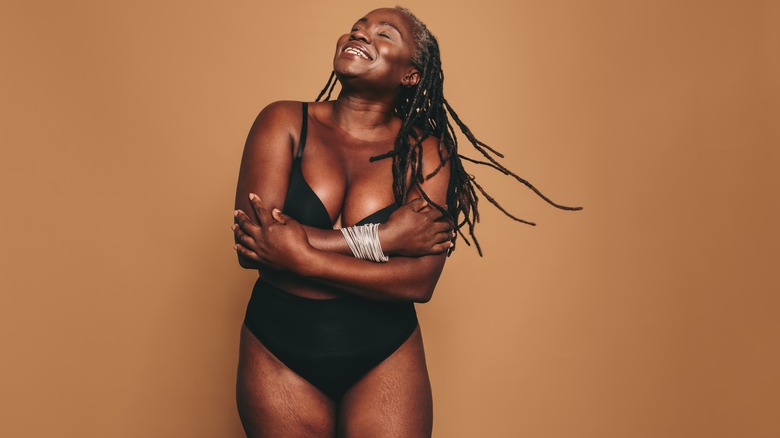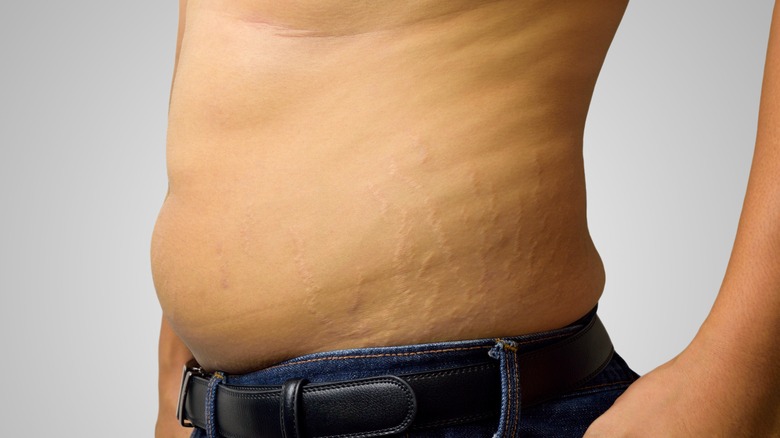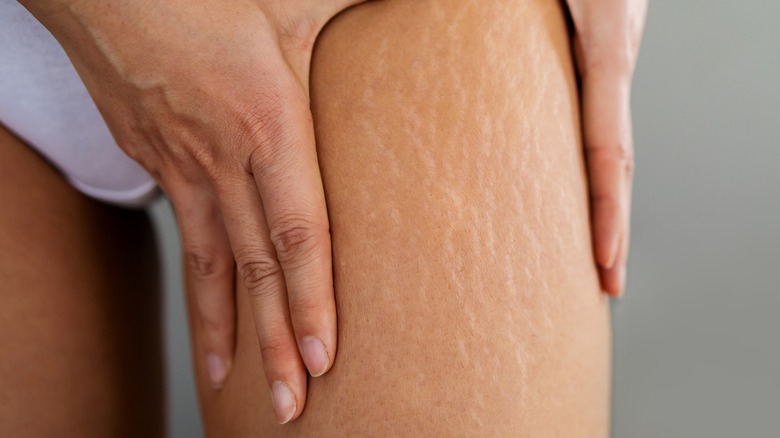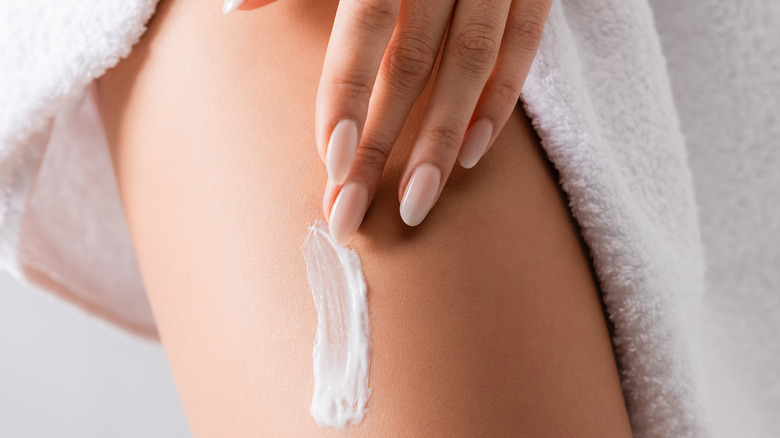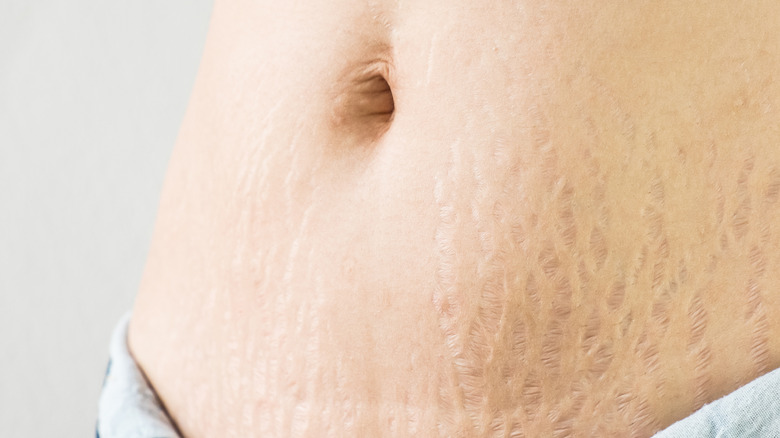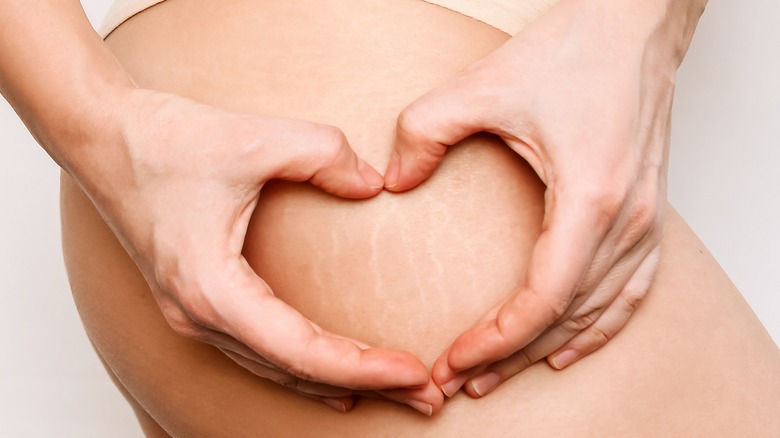You Have To Stop Believing These Myths About Stretch Marks
Despite being a physical badge of growth and change, stretch marks don't get the respect they deserve. Sometimes, at first sight of them, people will clamor to find ways to either get rid of them or hide them, as if they're something to be ashamed of. But considering up to 80% of the population is likely to get stretch marks throughout their life, they really shouldn't be something that we fear (via Journal of Investigative Dermatology). If anything, stretch marks should be something we embrace and celebrate as part of the human body.
"Stretch marks may occur after puberty, although there are also familial traits, ancestry, or hormonal traits (estrogen) to consider, too," Harold Lancer, M.D. tells Insider. "But there's usually a body mass shifting with either weight gain or weight loss or fluid retention that causes a stretching component to the skin."
Because stretch marks don't get the love they deserve, here are some stretch mark myths that need debunking.
Only women get stretch marks
We tend to think that stretch marks only develop on women, but the reality is stretch marks know no gender (via Nivea). Men have skin too, and can gain and lose weight, experience hormonal changes, and have growth spurts, so why wouldn't they also be prone to stretch marks?
Although they can pop up on any part of the body, the most common places for stretch marks to develop are on the abdomen, breasts, buttocks, and hips (via Mayo Clinic). While being genetically female is a factor that can increase your likelihood of getting stretch marks, all humans grow (and eventually shrink with old age), and because our skin moves with us, it only makes sense it would weather a bit of wear and tear along the way, no matter our gender.
Thin people don't get stretch marks
Similar to men, thin women — wait for it — also have skin! And just like everyone else with skin, thin women can experience changes in their bodies that can ultimately be reflected on their epidermis (via Every Bodi).
Stretch marks can also appear on thin women who have lost an excessive amount of weight very quickly. If you're actively trying to lose weight, a good rule of thumb, according to PureWow, is to "aim to lose no more than two pounds per week to give your body time to adapt to the change."
You can't prevent stretch marks
If you gain or lose a lot of weight in a short amount of time, you can't expect your skin not to show the results of this weight difference. And some people are simply predisposed to getting stretch marks, which they can thank genetics for (via Women's Health).
However, experts do agree that the daily practice of keeping your skin moisturized, especially with products with vitamins A and E, can help in preventing stretch marks (via PureWow). This is because regular moisturizing aids in giving skin the elasticity it needs so it can adjust better to physical changes from weight loss and gain.
So, while everyone can't fully prevent them, you can moisturize, moisturize, moisturize and keep your skin's elasticity on the up and up.
There's only one type of stretch mark
Not only do stretch marks differ in size, as far as their length and the amount of space they take up on the body, but they can also differ in texture too (via The Clifford Clinic). Some stretch marks are flat and can't be felt when touched, while others can have an appearance of being actually in the skin like that of a scar.
Color variations are common as well, with some stretch marks appearing dark red, blue, purple, or even black. Sometimes stretch marks turn white with time, or they can appear white right off the bat. Each color has its own technical name, too. For example, according to a study published in StatPearls, stretch marks that occur after pregnancy are called striae gravidarum, red ones are called striae rubrae, and white ones are known as striae albae.
Stretch marks go away on their own
While some stretch marks will fade with time, having them completely go away and disappear forever likely just won't happen (via StyleCaster). And maybe that's a good thing as they can be a reminder of what your body is capable of in regard to change and growth. Hopefully, they can be perceived as something beautiful, instead of something ugly.
But, if you're wondering, there are treatments to help those with really bad stretch marks. According to Healthline, microdermabrasion, laser therapy, microneedling, and chemical peels are all medical procedures that can help visibly improve the appearance of stretch marks.
But keep in mind that visibly improving their appearance and eliminating them completely are two completely different things. So should you pursue having them removed by a professional, it's important to have realistic expectations. And if you choose to do nothing about them, it can help to remember that you're certainly not the only one out there with stretch marks.
